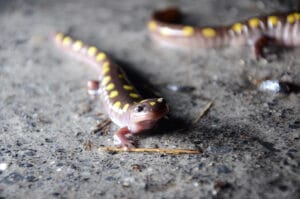The spotted salamander (Ambystoma maculatum) provides an opportunity to explore a singularly unique symbiosis in the vertebrate world. The alga Oophila amblystomatis is found nowhere in the world but inside the spotted salamander embryo. It uses the embryo as a host, absorbing nitrogen and carbon dioxide expelled by the growing salamander, while the salamander benefits from oxygen and sugar produced during the algae’s photosynthesis.
The discussion will focus on the historical and scientific perspective of this unique symbiosis dating back to first published observations in 1888 to modern day methods at the molecular level. We will also learn how the spotted salamander has been incorporated into Carroll County Public Schools science curriculum through a program that engage students and teachers in the rearing of spotted salamanders to better understand their unique symbiosis.
Mr. J. Adam Frederick is the Assistant Director for Education at Maryland Sea Grant College (MDSG). In his 26th year with MDSG, he serves as an education and research collaborator at Institute of Marine and Environmental Technology (IMET) in Baltimore, MD. He has developed and promoted a number of projects that promote research, environmental conservation and restoration of native species combined with essential elements of project-based learning in the classroom. With colleagues at MDSG, Mr. Frederick develops interactive lessons for the Maryland Sea Grant website and is the co-editor of educational materials on the web including 5e lesson plans and interactive lessons. Signature education programs include the VIRTUE-s / Biofilms and Biodiversity project that provides teachers and students the opportunity to work collaboratively with research scientists and international school partners, the Aquaculture in Action program that focuses on teacher professional development and the implementation of recirculating aquaculture in the formal classroom as tool for teaching science, and the Spotted Salamander Project that provides the opportunity for teachers and students to engage in the raise and release of spotted salamanders and gain insight into their unique symbiosis. He received his B.S. in Biology/Education from Slippery Rock University, PA and an M.S. in Environmental Biology from Hood College in Frederick, Maryland. In his 35 years of education experience he has been awarded the Tandy Technology Scholars Teaching Award, the Non-Traditional Teaching Award from the Mid-Atlantic Marine Education Association, and the James Centorino Award from the National Marine Educators Association (NMEA). Mr. Frederick has served as the President of the Sea Grant Education Network, the Mid-Atlantic Marine Education Association, and the National Marine Educators Association.
Registration
- Suggested Donation : $5
To register for this event, please follow this link: https://www.marylandnature.org/get-involved/events/event/natures-odd-couple-spotted-salamanders-and-algae/

